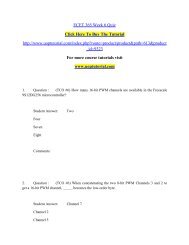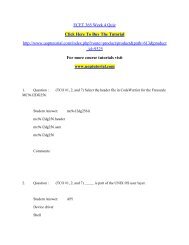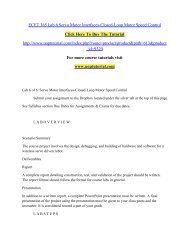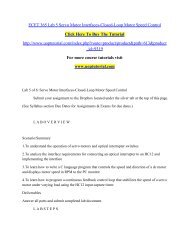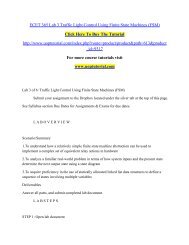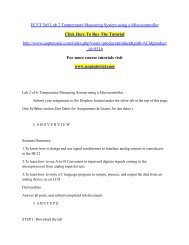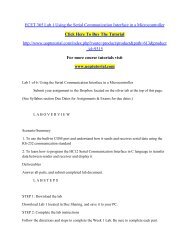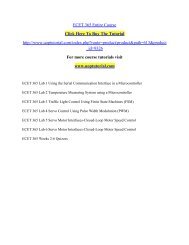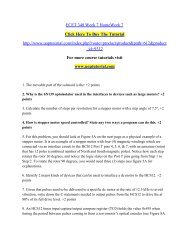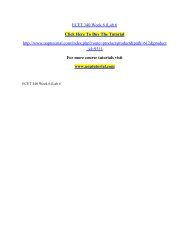ECET 365 Week 2 Quiz
- No tags were found...
You also want an ePaper? Increase the reach of your titles
YUMPU automatically turns print PDFs into web optimized ePapers that Google loves.
<strong>ECET</strong> <strong>365</strong> <strong>Week</strong> 2 <strong>Quiz</strong><br />
Click Here To Buy The Tutorial<br />
http://www.uoptutorial.com/index.php?route=product/product&path=613&product<br />
_id=9321<br />
For more course tutorials visit<br />
www.uoptutorial.com<br />
1. Question : (TCO #5) Identify the step size for an 8-bit analog-to-digital converter<br />
with Vref= 2.5 VDC?<br />
Student Answer:<br />
10 millivolts<br />
25 millivolts<br />
4.9 millivolts<br />
5 volts<br />
Comments:<br />
2. Question : (TCO # 5) How many steps are available with a 10-bit ADC?<br />
Student Answer: 10<br />
1024<br />
512<br />
256<br />
Comments:
3. Question : (TCO #5) What is the cutoff frequency for a low-pass filter with a resistor<br />
R = 3000 and a capacitor C = .01 µf?<br />
Student Answer:<br />
f = 5.3 KHz<br />
f = 3300 Hz<br />
f = 120 KHz<br />
f = 6 KHz<br />
Comments:<br />
4. Question : (TCO #5)A band-stop filter is a filter that _____ frequencies below lowlimit<br />
and above high-limit frequencies and _____ frequencies between the limits.<br />
Student Answer:<br />
blocks; blocks<br />
passes; blocks<br />
blocks; passes<br />
has; blocks<br />
Comments:<br />
5. Question : (TCO #5) A bridge with R1= 5.1 K, R2= 2 K, and R3= 15 K can be at null<br />
if R4is _____.<br />
Student Answer:<br />
10.5 K<br />
5.88 K<br />
588
1 K<br />
Comments:<br />
6. Question : (TCO #5) An instrumentation amplifier with two buffers has a feedback<br />
resistor of 100 K. The two resistors from the buffer's output to the input of the last stage OP-<br />
Amp are 1 K resistors. Voltage levels to the non-inverting buffer inputs. Voltage levels to the<br />
non-inverting buffer inputs are V1= .06 volt and V2= .02 volts. What is Voutof the<br />
instrumentation amplifier?<br />
Student Answer:<br />
4 Volts<br />
Student Answer:<br />
4 Volts<br />
20.4 Volts<br />
3.3 Volts<br />
15.3 Volts<br />
Comments:<br />
7. Question : (TCO #5) An embedded system with an 8-bit analog-to-digital converter is<br />
connected to a transducer with an output voltage of 10 millivolts. This signal is amplified by an<br />
amplifier with a gain of 25. Assume that this signal level is appropriate for the ADC input. If the<br />
reference voltage of the ADC converter is 5 volts, what will be the output of the ADC in binary<br />
form?<br />
Student Answer: 01100110<br />
00110011<br />
00001101<br />
01111011
Comments:<br />
8. Question : (TCO #5) An 8-bit analog-to-digital converter has maximum output<br />
voltage of 2.5 VDC. What is the reference voltage to this ADC?<br />
Student Answer:<br />
2.5 VDC<br />
5 VDC<br />
1.25 VDC<br />
None of the above<br />
Comments:<br />
9. Question : (TCO #5) A well-behaved analog signal with a frequency of 20 kHz is<br />
being sampled. What is the sampling frequency if frequency aliasing occurs?<br />
Student Answer:<br />
90 kHz<br />
40 kHz<br />
85 kHz<br />
60 khz<br />
Comments:<br />
10. Question : (TCO #5) To model a nonlinear transducer, one can _____.
Student Answer:<br />
use empirically determined nonlinear equation<br />
use a piecewise linear system<br />
use a lookup table located in memory<br />
All of the above



